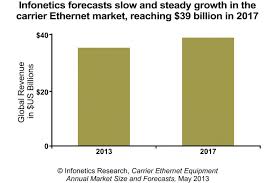Carrier Ethernet has become mainstream as a business transport technology, according to Infonetics Research, which projects that Carrier Ethernet equipment ports will top 95 million worldwide by 2017, with 10 Gigabit Ethernet growing fast to pass 1 Gigabit Ethernet.
Adoption rates for Ethernet services in the United States are soaring, driving revenue from $5.2 billion in 2012 to $9.2 billion in 2016, according to research from IDC. High-bandwidth applications such as data-center connectivity, disaster recovery/business continuity, and data storage replication are the three primary applications driving Ethernet adoption, the research firm said.
Infonetics said that for now, Asia Pacific accounts for the greatest portion of Carrier Ethernet equipment revenue, followed by Europe, the Middle East, and Africa (EMEA). However, by 2017, Infonetics expects North America will have passed EMEA to become the second-largest Carrier Ethernet market.
“Carrier Ethernet is now a permanent, inseparable part of service provider networks, and the market has reached a steady state of investment as a result,” noted Michael Howard, principal analyst for carrier networks and co-founder of Infonetics Research. “Though spending on legacy technologies like SONET/SDH and WDM will decline, investment in IP routers, carrier Ethernet switches and Ethernet access devices will continue to rise, driven by the move to IP NGN and, of course, growing traffic—particularly video traffic.”
Howard added: “We see the carrier Ethernet market growing slow but steady over the next 5 years, reaching about $39 billion in 2017.”










